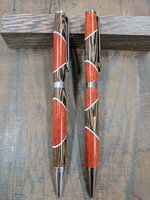JonathanF1968
Member
How would you cut a blank diagonally?
Here's my thought. I want to take two different pieces of wood (i.e., blanks), cut them both diagonally, and then glue them together to make one blank that is both types of wood. Sort of like segmenting, except it's just to big segments.
The wood I want to use is rosewood and either maple or apple; the pen is for a friend of mine who has ties to both New England and Brazil, and I want to make one of wood from both places. I haven't done any segmenting, but my thought is to keep it super simple so that you can see the wood grain and not be distracted by patterns, which I am likely to screw up on my first foray!
So, how to cut the blanks. I have a compound miter saw (which I use for most of my blank making) and also a table saw, but I think the miter saw will be a better tool for this. It is going to be thin enough that I will need some sort of jig or other support to hold it in the right spot against the fence.
Alternatively, I could use the table saw at a 45 degree angle, but the blank is a little small for this kind of fussy work, and my table saw doesn't seem to give as clean a cut, so some sanding of the glued edge would be required to get a tight fit. Maybe on the belt sander, if I decide the table saw is the way to go.
Any tips? I haven't done anything like this before. Assuming Titebond is the glue of choice, and maybe wrapping it with gauze or perhaps duct tape before drilling would be helpful?
--Jonathan
Here's my thought. I want to take two different pieces of wood (i.e., blanks), cut them both diagonally, and then glue them together to make one blank that is both types of wood. Sort of like segmenting, except it's just to big segments.
The wood I want to use is rosewood and either maple or apple; the pen is for a friend of mine who has ties to both New England and Brazil, and I want to make one of wood from both places. I haven't done any segmenting, but my thought is to keep it super simple so that you can see the wood grain and not be distracted by patterns, which I am likely to screw up on my first foray!
So, how to cut the blanks. I have a compound miter saw (which I use for most of my blank making) and also a table saw, but I think the miter saw will be a better tool for this. It is going to be thin enough that I will need some sort of jig or other support to hold it in the right spot against the fence.
Alternatively, I could use the table saw at a 45 degree angle, but the blank is a little small for this kind of fussy work, and my table saw doesn't seem to give as clean a cut, so some sanding of the glued edge would be required to get a tight fit. Maybe on the belt sander, if I decide the table saw is the way to go.
Any tips? I haven't done anything like this before. Assuming Titebond is the glue of choice, and maybe wrapping it with gauze or perhaps duct tape before drilling would be helpful?
--Jonathan




